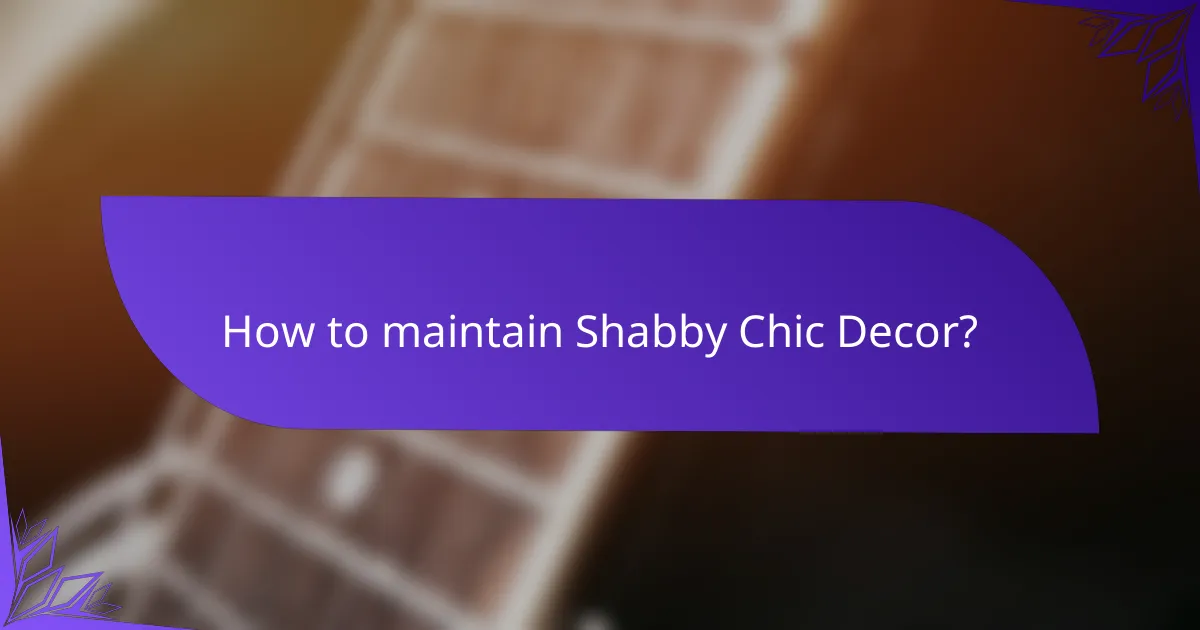Shabby Chic decor offers a charming blend of vintage elegance and cozy comfort, making it a popular choice for those looking to create a warm atmosphere on a budget. Thrift store shopping is a treasure hunt for unique, distressed items that can be easily repurposed, while DIY projects allow you to personalize your space with character and charm. By focusing on affordable materials and creative upcycling, you can achieve a stylish Shabby Chic aesthetic without breaking the bank.

How to find Shabby Chic Decor in thrift stores?
Finding Shabby Chic decor in thrift stores involves looking for vintage or distressed items that can be repurposed or restored. Focus on furniture, textiles, and decorative pieces that have a worn, rustic charm, which is the essence of the Shabby Chic style.
Popular thrift store chains
Some of the most popular thrift store chains include Goodwill, Salvation Army, and Value Village. These stores often have a wide selection of second-hand items, making them ideal for sourcing Shabby Chic decor. Local independent thrift shops can also yield unique finds that larger chains may not offer.
Tips for successful thrift shopping
To maximize your thrift shopping experience, visit stores frequently and at different times to catch new arrivals. Bring a measuring tape to ensure that larger items will fit in your space. Don’t hesitate to negotiate prices, especially if an item shows signs of wear.
Consider focusing on items that can be easily refurbished, such as chairs that need reupholstering or tables that can be painted. Always check for structural integrity and potential repairs before purchasing, as this can save you time and money in the long run.
Best cities for thrift shopping
Cities known for excellent thrift shopping include Portland, Oregon; Austin, Texas; and San Francisco, California. These locations often have a vibrant thrift culture, with numerous shops offering a variety of vintage and unique items. Additionally, cities with a strong artistic community tend to have more eclectic thrift stores.
When visiting these cities, plan your route to include multiple stores in one trip, as many are located close to each other. This can help you discover a wider range of Shabby Chic decor options without spending too much time traveling between locations.

What DIY projects enhance Shabby Chic Decor?
DIY projects that enhance Shabby Chic decor focus on creating a vintage, cozy aesthetic using repurposed items and soft colors. Key projects include upcycling furniture and creatively using fabrics to add character and charm to your space.
Easy furniture upcycling ideas
Furniture upcycling involves transforming old or thrifted pieces into stylish focal points. For example, consider painting a worn-out wooden chair with pastel chalk paint and distressing the edges for a vintage look. You can often find suitable pieces at local thrift stores for under $50.
Another idea is to re-stain or refinish a coffee table. Sanding it down and applying a light whitewash can give it a fresh, airy feel. Always ensure to use non-toxic finishes, especially if you have children or pets around.
Creative fabric repurposing techniques
Repurposing fabric is a great way to incorporate Shabby Chic elements into your decor. Old linens, lace, or even worn-out clothes can be transformed into throw pillows or table runners. Look for fabrics with floral patterns or soft textures that evoke a cozy atmosphere.
Additionally, consider making fabric wall art by stretching vintage fabric over a canvas. This not only adds color but also texture to your walls. When selecting fabrics, aim for a mix of patterns and solids to create visual interest while maintaining a cohesive look.

How to budget for Shabby Chic Decor?
Budgeting for Shabby Chic decor involves planning your spending to achieve a stylish look without overspending. Focus on sourcing affordable materials and incorporating DIY projects to maximize your budget.
Cost-effective sourcing strategies
To find cost-effective decor items, consider shopping at thrift stores, garage sales, and flea markets. These venues often have unique pieces at a fraction of retail prices, allowing you to create a personalized look.
Online marketplaces like Craigslist or Facebook Marketplace can also yield great finds. Look for local listings where you can negotiate prices and avoid shipping costs.
Budgeting tips for DIY projects
When planning DIY projects, set a clear budget for materials and tools. A good rule of thumb is to allocate around 20-30% of your total decor budget for DIY supplies, ensuring you have enough to cover unexpected costs.
Start with simple projects that require minimal materials, such as repainting furniture or creating wall art. This approach allows you to gradually build your skills and confidence without overspending.
Keep track of your expenses and compare prices for materials at different stores. Utilizing coupons and sales can further stretch your budget, making it easier to achieve your Shabby Chic vision.

What are the key attributes of Shabby Chic style?
Shabby Chic style is characterized by a soft, vintage aesthetic that combines elegance with a rustic charm. Key attributes include distressed furniture, pastel colors, and a mix of old and new decor elements that create a cozy, inviting atmosphere.
Color palettes and materials
Shabby Chic color palettes typically feature soft, muted tones such as pale pinks, light blues, creamy whites, and gentle greens. These colors evoke a sense of tranquility and warmth, making them ideal for creating a relaxed environment.
Materials often used in Shabby Chic decor include weathered wood, vintage fabrics, and distressed metals. Mixing textures, like lace and burlap, can enhance the style’s charm and create visual interest without overwhelming the space.
Essential design elements
Key design elements of Shabby Chic include vintage furniture, floral patterns, and decorative accessories like antique mirrors and mismatched china. Incorporating these elements helps to achieve the layered, lived-in look that defines this style.
To effectively embrace Shabby Chic, consider using DIY projects to upcycle thrift store finds. For example, repainting an old chair in a pastel hue or reupholstering a vintage sofa with floral fabric can add personal touches while staying budget-friendly.

How to maintain Shabby Chic Decor?
Maintaining Shabby Chic decor involves regular cleaning, careful repairs, and mindful preservation of vintage items. This style thrives on a balance between rustic charm and functionality, ensuring that each piece remains both beautiful and practical.
Cleaning and care tips
To keep Shabby Chic decor looking its best, use gentle cleaning methods. Opt for soft cloths and mild, eco-friendly cleaners to avoid damaging delicate finishes. Regular dusting and spot cleaning can help maintain the integrity of vintage pieces.
Avoid harsh chemicals that can strip paint or finishes. Instead, consider using a mixture of vinegar and water for a natural cleaning solution. For upholstered items, vacuuming regularly and using fabric fresheners can keep them fresh and inviting.
Repairing vintage items
Repairing vintage items is essential for maintaining their charm and functionality. Start by assessing the damage and determining whether a simple fix, like tightening screws or re-gluing joints, will suffice. For more significant repairs, consider using wood glue or epoxy for structural issues.
When dealing with cosmetic damage, such as scratches or chips, touch-up paint or furniture wax can help restore the original look. Always test any repair materials on a small, inconspicuous area first to ensure compatibility with the existing finish.

What are the best online resources for Shabby Chic Decor?
The best online resources for Shabby Chic Decor include a mix of DIY blogs, social media platforms, and specialized websites. These platforms offer inspiration, tutorials, and community support for those looking to create a charming and vintage-inspired aesthetic on a budget.
Popular DIY blogs and websites
Several DIY blogs and websites focus specifically on Shabby Chic decor, providing tutorials, project ideas, and tips for sourcing materials. Notable examples include Shabby Chic, which features a range of articles on styling and crafting, and Better Homes & Gardens, which often showcases budget-friendly projects.
When exploring these sites, look for sections dedicated to DIY projects, as they often include step-by-step guides and material lists. This can help you visualize the process and gather everything you need before starting your own Shabby Chic transformations.
Social media inspiration sources
Social media platforms like Pinterest and Instagram are excellent for finding Shabby Chic decor inspiration. On Pinterest, you can search for boards dedicated to Shabby Chic styles, which often feature a variety of DIY projects and decor ideas that can be saved for later reference.
Instagram is another valuable resource, where you can follow hashtags such as #ShabbyChic and #DIYDecor to discover real-life applications of the style. Engaging with posts and following creators who specialize in this aesthetic can provide ongoing inspiration and connect you with a community of like-minded enthusiasts.

What emerging trends are shaping Shabby Chic Decor?
Emerging trends in Shabby Chic decor focus on sustainability, modern aesthetics, and personalization. These trends encourage the use of vintage elements while incorporating contemporary design principles, making the style more versatile and appealing to a broader audience.
Eco-friendly materials and practices
Eco-friendly materials are becoming essential in Shabby Chic decor, emphasizing sustainability and reducing environmental impact. Common materials include reclaimed wood, recycled fabrics, and low-VOC paints, which help create a charming, rustic look while being kind to the planet.
Practices such as upcycling and repurposing thrift store finds are also gaining popularity. For example, transforming an old dresser into a stylish TV stand not only saves money but also minimizes waste. Look for items that can be easily refreshed with paint or new hardware.
Modern interpretations of Shabby Chic style
Modern interpretations of Shabby Chic style blend traditional elements with contemporary design. This includes pairing vintage furniture with sleek, modern accessories or using bold colors alongside soft pastels to create a fresh look. Mixing textures, such as combining distressed wood with smooth metals, adds depth and interest.
Incorporating technology, like smart lighting or modern art, can also enhance the Shabby Chic aesthetic while keeping it relevant. Consider using LED lights in vintage fixtures or displaying abstract art on a distressed wall to create a unique focal point that bridges the gap between old and new.


